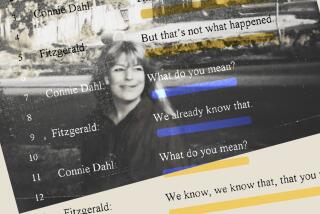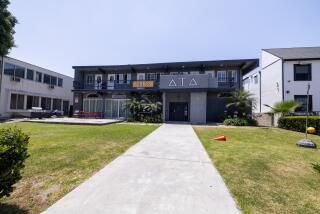Case of I-5 Rest-Stop Shooting Goes to the Jury
- Share via
Was Eric Hazelgrove the victim of a plot to send him back to prison, or was he a cold-blooded killer who stalked and shot his victim five times?
The fate of the 30-year-old Southeast San Diego man rests with a Vista Superior Court jury, for whom opposing attorneys painted sharply divergent pictures Monday of the shooting of a 56-year-old black man who worked as a lunch wagon vendor at an Interstate 5 rest stop.
Lee Harrell survived the August shooting and has testified against Hazelgrove during the weeklong trial.
Deputy Dist. Atty. Greg Walden argued that Hazelgrove, who is charged with two counts of attempted murder and two lesser counts, shot Harrell once as the vendor stood near the front of his lunch wagon at the crime-plagued Aliso Creek rest stop north of Oceanside, then followed him as he tried to escape and shot at him five more times.
“It is only by the grace of God that this man is not a murderer,” Walden said of Hazelgrove in his closing argument. “Mr. Harrell is one tough old guy.
“God was smiling down on Mr. Harrell, or we would be talking here about first-degree murder,” Walden said.
After delivering the “coup de grace” to the fallen and bleeding Harrell, he said, Hazelgrove stuffed the empty gun back under his belt “and cruelly and calmly (went) back to his truck and (drove) away.”
Defense attorney Barbara McDonald described her client as a possible victim of a plot, and questioned how he could have been bent on killing a man he never met.
McDonald attacked Walden’s version of the crime, stressing to the jury that the prosecutor “wants you to believe that this was a willful and repeated attempt to murder a man he had never met. There is no evidence whatsoever that Eric Hazelgrove was acquainted with Lee Harrell.”
Attempts to portray Hazelgrove as a “racist pig” were unfounded, McDonald said. She called the racism issue “a red herring that has been drawn in in an attempt to explain a totally unexplainable situation.”
McDonald argued that the prosecution had failed to produce a believable motive that would explain why Hazelgrove shot Harrell. She said Hazelgrove himself is convinced that someone “set him up” for the crime and swears that he was nowhere near the rest stop at the time of the shooting.
“There was no evidence that anybody was going to shoot anybody,” the defense attorney said. To prove that the shooting was attempted murder, she said, it had to be shown that “there was a real intent to kill someone, more than an unconsidered and rash impulse.”
The use of a .22-caliber weapon, the position of the bullet wounds below the waist of the victim and the fact that Hazelgrove had had no contact with the vendor before the shooting “don’t support the conclusion that there was an attempt to go out there and blow somebody away,” McDonald said.
She asked the jury to remain skeptical about “the kind of conclusions witnesses have been led into” by Walden in his prosecution. There were other people at the rest stop with motives to put the blame for the crime on Hazelgrove, she argued, and their testimony should be judged in that light.
McDonald cited the two women, Kerry Wagner and her cousin Jennie Wagner, who were in the car with Hazelgrove when the shooting occurred, and asked why the district attorney’s office had not released the results of gunpowder tests on Hazelgrove’s hands or evidence of fingerprints on the gun used in the shooting.
Both lawyers agreed that a wild chase followed the shooting, ending in a San Juan Capistrano shopping center parking lot, but they disagreed over whether Hazelgrove’s driving had endangered other people on the road.
Walden described Hazelgrove’s attempt to evade six or seven police, Sheriff’s Department and California Highway Patrol cars as “Mr. Toad’s Wild Ride,” during which the two female passengers “were afraid for their lives.”
Hazelgrove drove north on I-5 at speeds reaching 85 m.p.h., weaving through traffic and once driving up an off-ramp, then cutting back to the freeway down an ice-plant-covered shoulder, Walden said.
But McDonald argued that no one had been injured or endangered by the chase, which ended when Hazelgrove’s former girlfriend, Kerry Wagner, grabbed the keys from the ignition and both women fled when the car came to a stop.
Hazelgrove, who has remained in County Jail at Vista on $1 million bail since the shooting, sat without emotion as the lawyers concluded their cases.
He is charged with two counts of attempted murder, both based on the shooting of Harrell; one count of reckless driving while fleeing to avoid capture, and one count of being a convicted felon in possession of a firearm.
Walden said conviction on all charges could bring a maximum sentence of 20 years to life in prison.
More to Read
Sign up for Essential California
The most important California stories and recommendations in your inbox every morning.
You may occasionally receive promotional content from the Los Angeles Times.










